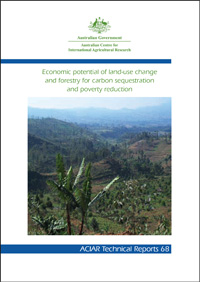- HomeHome
-
About ACIAR
- Our work
- Our people
-
Corporate information
- ACIAR Audit Committee
- Commission for International Agricultural Research
- Policy Advisory Council
- Agency reviews
- Executive remuneration disclosure
- Freedom of information (FOI)
- Gifts and benefits register
- Information publication scheme
- List of new agency files
- Contracts
- Legal services expenditure
- Privacy impact assessment register
- Commonwealth Child Safe Framework
- Benefits to Australia
- Careers
- 40 years of ACIAR
-
What we do
- Programs
- Cross-cutting areas
- Resources
- Where we work
-
Funding
- Research projects
- Fellowships
-
Scholarships
- John Allwright FellowshipScholarships to study in Australia for ACIAR partner country scientists to have Australian postgraduate qualifications
- ACIAR Pacific Agriculture Scholarships and Support and Climate Resilience Program
- Alumni Research Support Facility
- Publications
- News and Outreach
Technical report
Economic potential of land-use change and forestry for carbon sequestration and poverty reduction
Date released
14 May 2008
Publication Code
TR068
Overview
Concerns over global warming have led to the establishment of markets for greenhouse gas emissions, in particular for carbon dioxide (CO2). Tree-based systems are a convenient way of reducing net emissions by sequestering CO2 from the atmosphere. Carbon credits do not require transport to markets, and are thus appealing as a commodity for rural smallholders in developing countries. However, as for any other commodity, profitability is related to prices received, costs of production (greenhouse gas abatement), and transaction costs, which remain largely unknown for smallholders in developing countries. This research focused on several agroforestry systems that have been adopted by smallholders in three regions of Indonesia, looking at how smallholders compare with other landholders in terms of efficiency in sequestering carbon, whether smallholders will want to adopt carbon-sequestering activities, and what sorts of policies and projects will underpin smallholder involvement.



